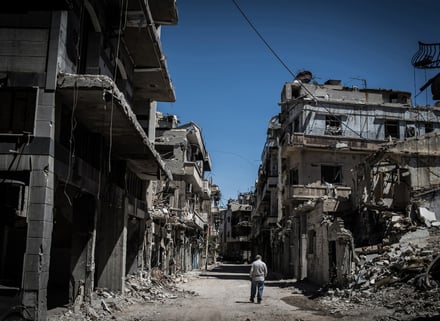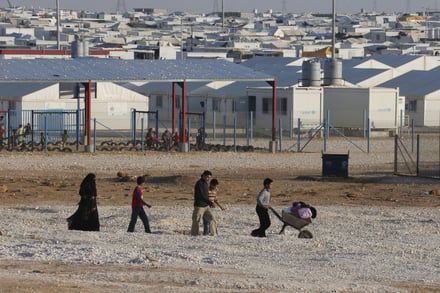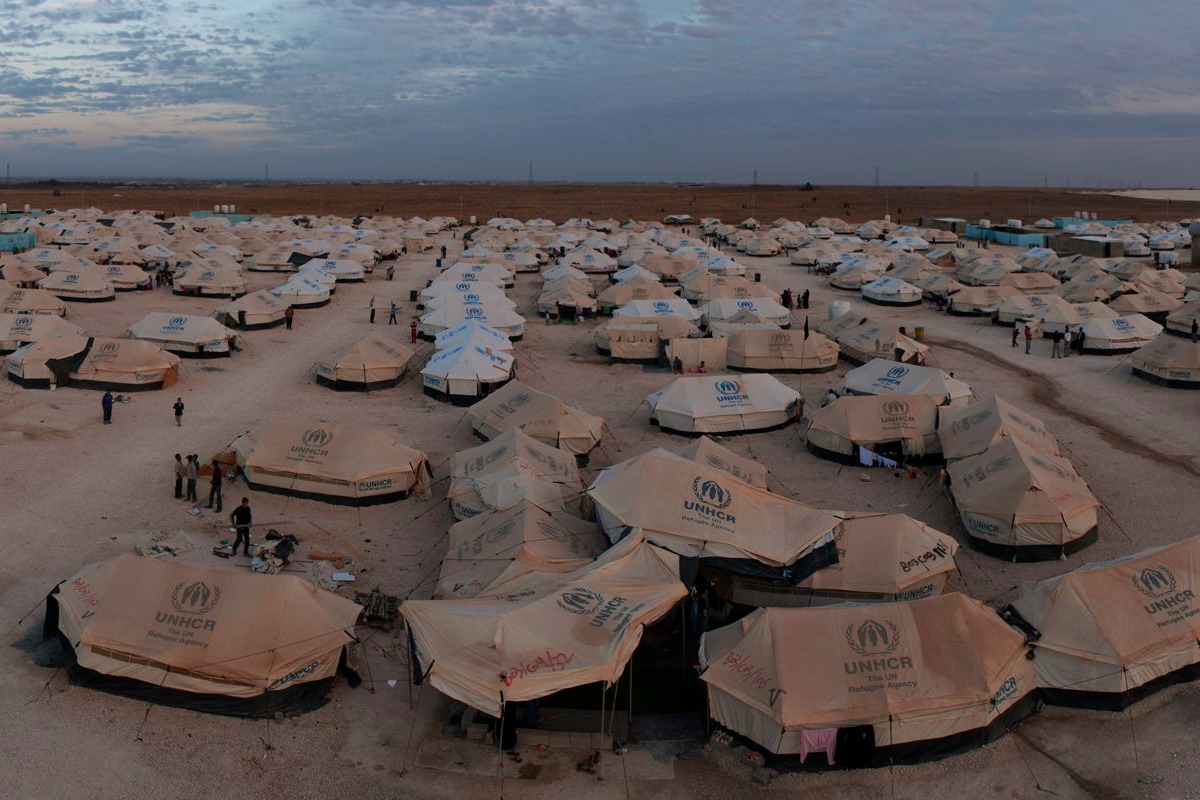Human Dignity vs. the Throwaway Culture
Human dignity is innate by virtue of each human person being made in the image of God. It is independent of a person’s role in society, talents and weaknesses, and demographic profile. Each person is entirely unique and irreplaceable. The persecuted, the degraded, the humiliated person has dignity. No one can strip a person of his or her dignity, even if they choose to ignore or violate it. A person does not lose their dignity if they become more dependent on others, as the dignity of the person can be neither forfeited nor stolen.
This mentality could not be more at odds with what Pope Francis has deemed the “throwaway culture”—a culture in which human beings are treated like consumer goods, used, and then summarily discarded. With this utilitarian mindset, the human person is debased, stripped of his or her humanity and personhood in the mind of the one who is objectifying them. And this utilitarian mindset is all too prevalent in today’s world.
We see it in the bourgeois liberalism that is popular in the West. Unborn children become “products of conception” that can be treated like waste or used for scientific experimentation. Those in the twilight of their lives are sent the message that they are nothing but a burden, that their lives no longer have value now that they are no longer able to serve a utilitarian purpose. The poor work for non-living wages, are denied basic needs, and get lectured by elites on the values that prop up a faux meritocracy that is actually rooted in structural injustice rather than merit or fairness. The economy is built on an insatiable consumerism that promises happiness and delivers only emptiness.
The reality of human dignity points to a different approach altogether, one rooted in a personalist understanding of the person and a communitarian understanding of the common good. A just society is oriented toward the flourishing of all, designed to allow each person to reach their full emotional, intellectual, physical, and spiritual development. The transcendent dignity of the person (and the person’s potential) is realized by living virtuously and avoiding sin, which damages the loving relationship he or she has with God and others.
In a just society, the dignity of each person is recognized and each has access to food, water, education, healthcare, employment, leisure, and the other necessities that dignity demands. The family and spiritual life of the person is respected. Men and women are given the freedom to realize their potential and serve one another, as they build the Kingdom of God together. The State and society serve persons. The sanctity of human life is recognized and protected. These are the prerequisites of human flourishing.
In an established democracy, these approaches can peacefully compete for the ability to shape policy outcomes. Even when certain policies fail to reflect human dignity, there is often space to live virtuous lives that are largely compatible with human dignity (assuming one has already been born). In many ways, this explains why free democracy, though imperfect, is the system most conducive to human flourishing.
Alternately, grave and seemingly inescapable threats to human dignity occur in totalitarian and violent authoritarian regimes. The freedom of the person is stifled under oppressive tyrannies that display a near-total disregard for human dignity and the demands it creates. The throwaway culture is bureaucratized and becomes official State policy, designed to perpetuate the rule of political elites and/or to serve some twisted dystopian fantasy. The freedom of religion and speech are often suppressed, as dictators recognize both the dangerous potential of religious humanism in inspiring people to stand for their rights as well as the way free speech enables citizens to mobilize for conditions compatible with their dignity.
It is within this context that we often witness one of the gravest threats to human dignity, which exposes the true depths of humanity’s capacity for evil: genocide and mass atrocities. Whether driven by complete indifference to human dignity or pure hatred for a group of persons, the direct and intentional slaughter of innocent people merits special consideration in terms of violations of human dignity.
And unfortunately, the present world has offered us far too many examples of these crimes against humanity. Some perpetrators have used the latest technology, while others have used machetes and blunt objects to carry out their crimes. The perpetrators range from formal state institutions to non-State actors to proxies of the State. The use of sexual violence is sometimes used in conjunction with killing to create a climate of terror and hopelessness.
Civilians are forced to flee, often leaving everything they have behind, along with any hope of living in conditions that would allow them to flourish. In refugee camps or as internally displaced persons, they struggle simply to survive. The person was not meant to live this way.
When the Arab Spring began, there was hope that 2011 might become another 1989, a seminal moment in the struggle for human freedom. Peaceful protesters took to the streets to protest incompetent regimes that suppressed their most basic rights. By early 2012, four of these regimes had been overthrown.
But the counterrevolutionary response was strong. Dictatorship returned to Egypt. Other regimes were able to hang on to power. In Syria, the worst possible scenario played out: Syrian dictator Bashar al-Assad attempted to retain power through a campaign of mass murder that is still ongoing years later. The United States and other liberal democracies have done little to undermine this counterrevolutionary wave. The result has been civil war with no end in sight, a powerful terrorist organization rising from defeat, and one of the worst humanitarian catastrophes in decades.
Syria
The images are horrifying. Rows of children lying motionless on the floor, murdered by their own government. The nature of the Assad regime, the authoritarian clique ruling Syria, was on full display. The Houla Massacre was a turning point in the Syrian civil war, which began with Bashar al-Assad’s brutal, violent response to peaceful protesters marching for their basic rights and for participation in their government. The massacre was a clear signal that the international community would respond to his atrocities with paralysis and inaction.
The images evoked memories of past genocides and mass atrocities from Auschwitz to Rwanda to Srebrenica, the latest illustration of the human capacity to perpetrate extraordinarily evil acts. Innocent children murdered because some men will do anything in the pursuit of power, whether the motive is some deranged ideology or simply because they lust for power and the personal benefits that come along with it. Years have passed, but the crimes continue; perhaps 19,000 children have been killed during the course of the war.
The Assad regime has bombed funeral processions. They have set children on fire, burning them to death at school.
To lose one’s child is every parent’s ultimate nightmare. Many would willingly trade their own life for the life of their child. These families are devastated. Their pain will endure. The ripple effects of these crimes against humanity will extend far beyond the immediate families of these murdered children. Syria has become a land of violence, fear, despair—and heartbreak.
 |
| Photo: Homs, Syria (2014) by Chaoyue Pan; CC BY-NC-ND 2.0. |
The feckless response of the international community, to be blunt, has been pathetic and shameful. The Assad regime responded to peaceful protests by igniting a conflagration that has resulted in the death of over 470,000 people. Around half of all Syrians have been displaced from their homes. Children have been out of school for years, the side effects of which will reverberate for decades.
The regime has bombed breadlines, where starving people lined up, desperate for food. It has used starvation itself as a tactic to win the war. Its snipers have targeted children who were searching for food, aiming for their foreheads.
The Assad regime has bombed funeral processions. They have set children on fire, burning them to death at school. They have consistently used barrel bombs, an indiscriminate weapon designed to not only rip apart human bodies, but to inflict terror on the population. They have buried whole families in stone, bombing them to death as they were sleeping in their own beds.
The regime has used chemical weapons, in such a gross violation of international norms and law that it almost elicited a forceful response from Western democracies and others. But this was averted, and now Assad just uses chlorine gas to suffocate the Syrian people.
The Assad regime has also fostered the rise of ISIS, a fanatical, sectarian group determined to impose violent theocratic totalitarianism. Assad released thousands of extremists from prison, has purchased oil from ISIS, and refused to bomb ISIS despite knowing its location as the organization built up strength. The regime’s strategy was to focus its fight on mainstream opposition groups so that the international community would be forced to choose between his murderous regime and ISIS extremists. The atrocities perpetrated by ISIS are the result of Assad’s strategy, and his status is the single most effective recruitment tool for the terrorists of ISIS. The war is still raging, despite a failed partial ceasefire, and the possible outcomes seem less acceptable each year.
Genocide and mass atrocities are among the gravest threats to human dignity in today’s world, along with abortion, global poverty, and the degradation of the environment. The direct and intentional killing of large numbers of innocent people is inevitably a major concern for those who believe in the value of human life and the dignity of the person.
Yet the response has been wholly inadequate, even among those inspired by Catholic moral and social teaching. The globalization of indifference has had a devastating effect on the people of Syria. The international community has been divided, with Assad’s allies—Russia, China, and Iran—protecting their fellow human rights violator at the United Nations. But the global community, made up of every person on the planet, has failed too. The absence of solidarity around the world shows the breadth of indifference. Even Pope Francis has failed to explicitly call out Assad’s mass murder and demand protection for all of Syria’s people.
The Responsibility to Protect
What is the proper response? Given the complexity of the conflict and the ever-changing dynamics on the ground, this is subject to debate. This is particularly true after Russia seized the initiative by intervening to prop up the struggling Assad regime, through a brutal military campaign that included war crimes. If the right response once constituted a no-fly zone, arming of the moderate opposition, creation of safe areas for civilians, the use of force against the Syrian air force (and other measures designed to protect the innocent and tip the scales toward an outcome that maximizes the possibility of a post-Assad government that is representative, accountable, and committed to basic rights), these measures may no longer be the right answer.
What should not be subject to debate, however, are the underlying moral principles: the right to life is universal; human dignity and the rights that flow from this dignity belong to all; and we have a responsibility to protect the innocent from mass murder. This understanding of reciprocal rights and duties is at the core of the Church’s communitarian worldview. Where there is a right to life, there is a corresponding responsibility to protect life and human dignity.
This norm—the Responsibility to Protect—has emerged in the last two decades, developing in the post-Cold War era when superpower rivalry no longer heightened the costs of all international interventions and raised the specter of nuclear annihilation. And it has been integrated into international law and embraced by the United Nations.
There are three pillars to the Responsibility to Protect in its formal delineation:
- The State carries the primary responsibility for protecting populations from genocide, war crimes, crimes against humanity and ethnic cleansing, and their incitement;
- The international community has a responsibility to encourage and assist States in fulfilling this responsibility;
- The international community has a responsibility to use appropriate diplomatic, humanitarian, and other means to protect populations from these crimes. If a State is manifestly failing to protect its populations, the international community must be prepared to take collective action to protect populations, in accordance with the Charter of the United Nations.
Pope Benedict XVI offered an endorsement of the Responsibility to Protect in an address at the United Nations in 2008:
Recognition of the unity of the human family, and attention to the innate dignity of every man and woman, today find renewed emphasis in the principle of the responsibility to protect. This has only recently been defined, but it was already present implicitly at the origins of the United Nations, and is now increasingly characteristic of its activity. Every State has the primary duty to protect its own population from grave and sustained violations of human rights, as well as from the consequences of humanitarian crises, whether natural or man-made. If States are unable to guarantee such protection, the international community must intervene with the juridical means provided in the United Nations Charter and in other international instruments. The action of the international community and its institutions, provided that it respects the principles undergirding the international order, should never be interpreted as an unwarranted imposition or a limitation of sovereignty. On the contrary, it is indifference or failure to intervene that do the real damage. What is needed is a deeper search for ways of pre-empting and managing conflicts by exploring every possible diplomatic avenue, and giving attention and encouragement to even the faintest sign of dialogue or desire for reconciliation.
Pope Benedict XVI drew a clear link between human dignity and the responsibility to protect. He added that “the universality, indivisibility and interdependence of human rights all serve as guarantees safeguarding human dignity.” Despite drawing this connection, however, official Church teaching has not formally integrated the Responsibility to Protect into its doctrine as an essential principle for safeguarding human dignity.
There are reasons some Catholics may oppose integrating this formula or even the simple norm itself into Church teaching. Despite the use of force only becoming an option as a last resort (as it is under Just War theory), pacifists and other anti-war Christians may be reluctant to embrace anything that could provide moral support for the use of force, particularly those actively trying to strip Just War theory from Church teaching. Catholics who favor stability and order over justice may fear that it undermines the international order and will destabilize countries or whole regions. Others may fear that it opens the door to neocolonial action by Western powers.
 |
| Photo: Syrian refugees at the Za'atari Refugee Camp (Jordan, 2014); Mohamed Azakir / World Bank Photos; CC BY-NC-ND 2.0. |
But Benedict XVI is right: a concern for human dignity should lead to an embrace of this norm. The universality of human dignity is the starting point of the Catholic understanding of human rights and their corresponding duties, within the context of the global common good. The person does not exist to serve his or her State; the State exists to serve persons. The Catholic understanding of a State’s legitimacy is tied to this responsibility. When the State violates the dignity of its people, it forfeits its legitimacy and does not have any right to autonomously perpetuate injustice and mass violence. The preservation of an unjust order for legalistic purposes is hard to reconcile with Catholic principles.
Where there is a right to life, there is a corresponding responsibility to protect life and human dignity.
Conversely, the Responsibility to Protect aligns with numerous Catholic principles. It is premised upon the existence of a global community that cuts across all the borders of the globe, an understanding that matches the Church’s catholic vision. It reflects subsidiarity, with the State’s responsibility to defend human dignity coming first. Only with the failure of the State does the international community have a responsibility to step in, first indirectly by helping a State that is struggling and then directly if the State is unable or unwilling to safeguard human dignity. The Responsibility to Protect also reflects a preferential option for the poor and vulnerable. The human dignity of regular people is placed above the power and autonomy of leaders who disregard it.
But is the Responsibility to Protect simply a pretext for a new form of colonialism? Certainly States can use a humanitarian guise to cover actions designed to enhance their power, security, or prosperity, but this possible deception and manipulation does not diminish the need for a responsibility to protect norm. Just War principles are manipulated for political purposes, but they remain necessary and valuable for evaluating the just use of force.
In reality, Benedict XVI is correct: the greater worry is not excessive intervention on humanitarian grounds, but indifference and inaction in the face of mass atrocities. This is particularly true in the wake of recent conflicts. As the world’s preeminent power, the United States has the most important role in ensuring that this norm is upheld. But the ill-planned and under-resourced occupation of Iraq (after a war fought on false grounds) and the perpetually under-resourced War in Afghanistan have produced less clear-cut results than were desired. The “leading from behind” strategy in Libya has made the promotion of good governance all but impossible. Given this track record, the United States may be reluctant to play a significant role in enforcing this norm, which is likely to make its enforcement untenable in most situations.
The greater worry is not excessive intervention on humanitarian grounds, but indifference and inaction in the face of mass atrocities.
The United States is not above international law, nor is it ordained by God as the savior of humanity. But superpowers have a greater ability to promote the global common good than other States, which gives them a greater responsibility to do so. To whom much is given, much is required. And States that are committed to the principles of freedom, the peaceful resolution of conflict, and democracy domestically (however imperfectly they live out these values) are far more likely to uphold the universal principles that allow for others to live in conditions that are compatible with human dignity than brutal authoritarian and totalitarian States that violate the rights of their own people. They will necessarily play a larger role in upholding this norm until there is a supranational mechanism for enforcement that holds leaders accountable.
All of this centers on the most contentious part of the Responsibility to Protect: the use of force as a last resort. There is far greater consensus on preventing these situations from arising and (to some extent) using other tools to protect civilians. But a diluted Responsibility to Protect, devoid of the possibility of force, will inevitably fail the most vulnerable people on the planet and expose them to horrific crimes against humanity. The greater the Responsibility to Protect norm becomes entrenched and the more consistently it is applied, it will serve not only to prevent crime but also to deter the most brutal regimes on the planet from engaging in mass murder. But even a partial application of this norm by a divided international community will be an upgrade from the status quo, where impunity poses one of the greatest threats to human dignity.
![]()
Featured Photo: Za'atari Refugee Camp in Jordan, courtesy of UNHCR; CC BY-NC 2.0.



